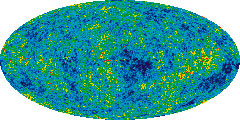Inflation and varying speed of sound
Inflationary models, beside addressing the traditional problems
of big-bang cosmology, offer a mechanism to generate the
primordial perturbations that eventually formed galaxies and
shape the Cosmic Microwave Background anisotropies.
A crucial feature of the observed primordial spectrum of
perturbations is that its amplitude is very mildly dependent
on the wavelength (scale-invariance). In the simplest
inflationary models this is the result of a primordial phase
of quasi de-Sitter expansion.
In scalar field models where the Lagrangian is a generic function of the kinetic term and of the field itself, perturbations can travel at a velocity (the velocity of sound) different than the velocity of light.
With Justin Khoury I explored a generalization of the above mechanism. We showed that an adiabatic scale invariant spectrum is produced even if the expansion -- albeit still inflationary -- is far from exponential, provided the speed of sound varies appropriately. We also found a class of contracting (``ekpirotic”) cosmologies where this mechanism can be applied. Non-gaussianity can be large in both the expanding and the contracting cases. The most relevant feature of our model is perhaps that the amplitude of the three point function exhibits a strong running with the scale. The mechanism that protects the scale invariance of the two-point function cannot in fact forbid a running of the three-point function. The gravitational wave spectrum is also tilted.
Bibliography:
J. Khoury and F. Piazza,``Rapidly-Varying Speed of Sound, Scale Invariance and Non-Gaussian Signatures'', JCAP 0907, 026 (2009) arXiv:0811.3633
Talks:
``Scale invariant spectrum and rapidly varying speed of sound''
- PI-CITA day, Toronto, 19/5/2009
- New Horizons for Modern Cosmology Galileo Galilei Institute, Florence (Italy), 2/2/2009
- ICG, Portsmouth, 15/1/2009

Full sky map of the Universe WMAP
Future directions:
Find general connections between the (quasi) scale invariance of the fluctuations and the (softly broken) symmetry of the underlying theory (it seems you have to pass through scaling symmetries)
See also: